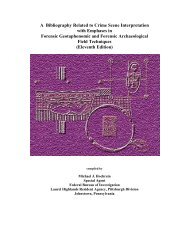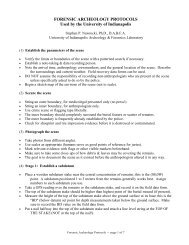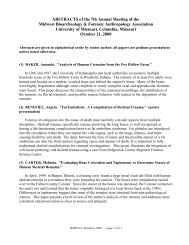Christopher W. Schmidt - University of Indianapolis Archeology ...
Christopher W. Schmidt - University of Indianapolis Archeology ...
Christopher W. Schmidt - University of Indianapolis Archeology ...
You also want an ePaper? Increase the reach of your titles
YUMPU automatically turns print PDFs into web optimized ePapers that Google loves.
CHAPTER 1: INTRODUCTION<br />
In the field <strong>of</strong> forensic anthropology, the construction <strong>of</strong> a reliable biological pr<strong>of</strong>ile <strong>of</strong><br />
the decedent is <strong>of</strong> utmost importance. The biological pr<strong>of</strong>ile provides valuable information that<br />
the authorities use as a starting point for the identification <strong>of</strong> the deceased and includes the age,<br />
sex, stature, and ancestry <strong>of</strong> the individual. Of these, ancestry is considered to be the most<br />
difficult to determine, least precise, and most controversial, in part because <strong>of</strong> the inherent<br />
complexity <strong>of</strong> its morphological indicators and the confusion between the biological and social<br />
definitions <strong>of</strong> ancestry (Reichs, 1986). The determination <strong>of</strong> ancestry is also crucial in<br />
archeological situations where sometimes, osteological material is the only evidence present for<br />
cultural affiliations (Cooprider et al. 1980).<br />
Despite these obstacles, there are techniques used by anthropologists to establish<br />
ancestral affiliation. The two most common methods employ metric (anthropometric) and non-<br />
metric (anthroposcopic) observations. Metric analysis involves taking measurements <strong>of</strong> the skull<br />
and applying discriminant function analysis to those measurements. Non-metric analysis<br />
involves scoring morphological variants <strong>of</strong> the skull on a discrete or discontinuous scale. The<br />
current study looks at ancestry determination using non-metric traits <strong>of</strong> the mandible. As such,<br />
non-metric traits are discussed in more detail before addressing the specifics <strong>of</strong> the current study.<br />
Non-Metric Analysis<br />
Non-metric skeletal traits are features that vary from one individual to another, are<br />
visually determined, and cannot easily be measured (Saunders, 1989; Schwartz, 1995). These<br />
traits are normal skeletal variants that are not expressed externally on the human body and are<br />
not pathological or traumatic in nature (Mays, 1998). Russel (1900) and Wood-Jones (1930<br />
1








